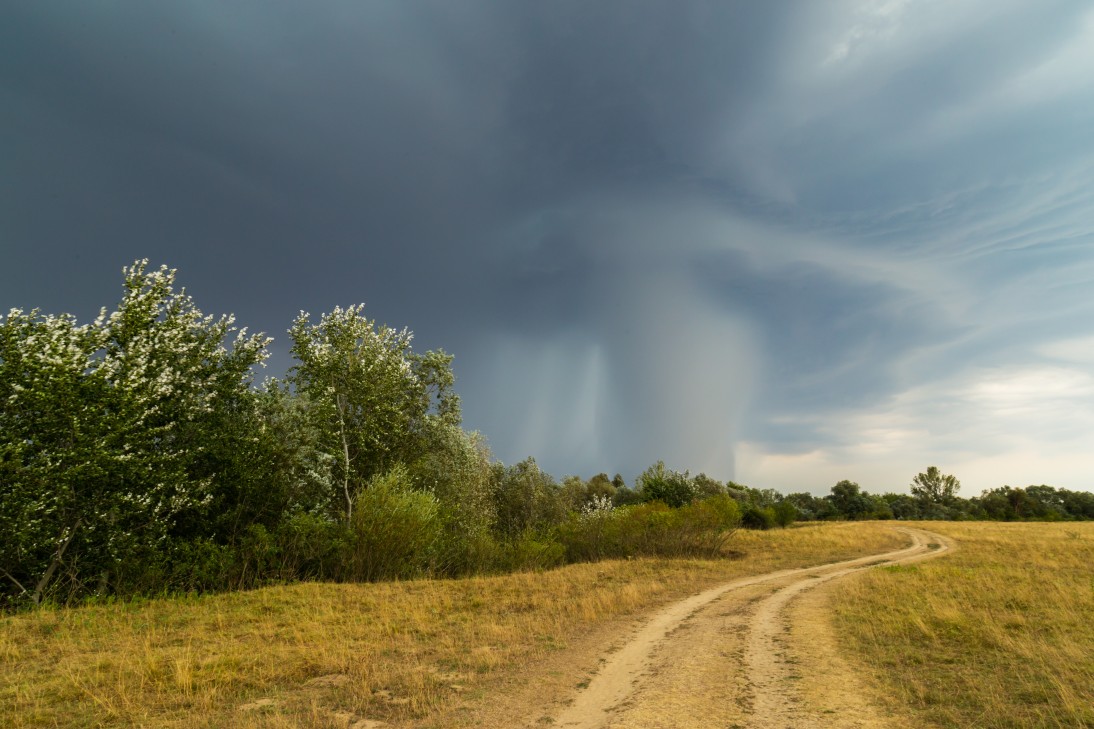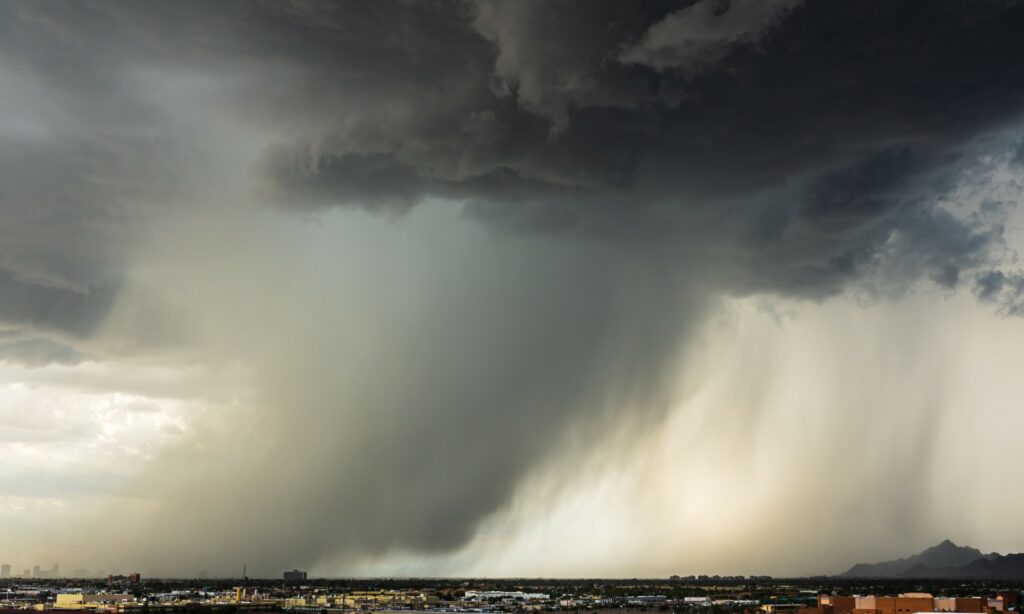
Heavy Rain, Flooding, and Chance of Severe Weather Staring Down the Southern U.S.
January 22, 2024
Posted: August 4, 2023 9:45 am





A severe thunderstorm leaves trees shattered and fallen, roofs blown off, and insurance companies’ phones ringing off the hook. But not all bursts of destructive weather are the same. Microbursts and tornadoes are two violent wind patterns that occur in similar environments and leave similar destruction but possess key unique characteristics.
A severe storm passing over the small historic area of Fredericksburg, Virginia left a wake of destruction so severe that residents and experts alike were left scratching their heads–and calling their insurance companies.
Decks were destroyed; porch furniture was twisted and snapped like mere twigs by the sheer force of the storm, and roofs were damaged. In the case of one homeowner, a huge backyard tree was completely uprooted, falling on the back porch and part of their roof. After a walk down the scenic park road Lee Drive near downtown Fredericksburg, it became clear that this was no ordinary storm.
Gigantic oaks littered the road, snapped like a dissatisfied housewife in a lifetime television special. “It looked like Bastogne,” one resident and Bands of Brothers aficionado commented. “Like trees just exploded everywhere.”
As residents cleared their yard of furniture-cum-kindling and swapped stories about the how and why of the sudden devastation, and determined that what had barreled through that small town on that late afternoon was known as a microburst.
“Felt like a tornado,” another resident said, and many agreed: so what is the difference?
Because the two are so easily confused, let’s take a look at exactly why they are difficult to tell apart. The key is mostly the surrounding circumstances; i.e., the meteorological environment and weather in which they both occur are pretty similar. Severe thunderstorms can be the breeding ground for both microbursts and tornadoes.
Thunder, lightning, and rain are the classic symptoms of the tempestuous environment that births both phenomena–and these symptoms occur because of a dramatic difference in air pressure between two fronts. However, there are a few key differences in both structure and environment behind each phenomenon.
The basic idea behind a microburst is an amount of force generated which cannot be contained by its current form and ends up releasing that force in a burst of destructive winds, hail, and rain. Cold and dry air feed into an existing thunderstorm, creating a cooling effect through evaporation.
A downdraft is created when a sudden burst or column of cool air that quickly shoots to the ground, and this cooling effect causes the downdraft to collapse. The force of this change creates winds that can rival a tornado.
There are two types of microbursts: wet and dry. Wet microbursts are common in the during the summer and are characterized by heavy precipitation.

Alternatively, tornadoes are funnel clouds of rotating air that maintain contact with both the ground and cloud cover at all times. One of the major components of a tornado is warm water. Storms that begin in warm water gulfs such as the Gulf of Mexico have a higher chance of forming tornadoes. There are many tornado or tornado-like meteorological phenomenon, such as:
These phenomenon are not always the same, nor do experts always agree on their differences. But they all generally involve funnel clouds of rotating air of varying intensity and meteorological conditions.
The biggest difference between microbursts and tornadoes is the direction of the air. Microbursts do not have rotating air; they have a sudden burst of cool air due to an inability for the downdraft to uphold the updraft. Because of this, experts will determine whether a recent storm was a microburst or a tornado by looking at the pattern of destruction and asking a few questions.
Residents of the Braehead Woods neighborhood of Fredericksburg, Virginia noticed that the trees in their backyard were rotating in the worst part of the storm.
When assessing the patterns of damage, experts looked for either a pattern of debris and fallen trees that resembled a fan (microburst) or a messy circle (tornado). A microburst will only travel as far as the force of its downdraft, but a tornado will travel as far as it can maintain its own momentum.
So microbursts will typically have a smaller range of destruction, and tornadoes will have more of a longer path. The worst tornado will typically have higher winds than the worst microbursts, but due to the explosive energy of the collapsing downdraft, the sudden violence of a microburst can bring the dangerous element of surprise.
Wind Speeds: up to 100 MPH
Destruction: Fan, sudden burst
Weather: Hot, humid combines with cool dry
Wind Speeds: 30-70 MPH typical, up to 301 MPH (recorded)
Destruction: circular, longer path
Weather: Hot, humid combines with cool, dry
To add more context to these two events, let’s look at the locations in which they most frequently occur. Because microbursts generally need an environment of warm, wet air to contrast with the dry, cooling effect, they normally are most common during summer afternoons in the Southeastern United States, when the humidity is highest.
Late summer in the South will typically have thunderstorms nearly every later afternoon, as pressure and humidity build throughout the day.
Tornadoes, on the other hand, are more common in places where there is more flat ground, because the flat areas allow the tornado to gain traction on the ground. Remember, tornadoes are a path of sustained momentum and their momentum will be slowed or stopped altogether by tall buildings and trees.
This is the same principle that governs the formation of hurricanes–wide stretches of water feed the momentum of a hurricane, so that the time it hits a coast it can have devastating effects. However, once a hurricane hits land, most of the time it will weakens as it moves and transform into a tropical storm as it moves inland.
Tornadoes also need an unobstructed path, and have also been known to occasionally form over water. Because of this, tornadoes are most common in Midwestern states where the terrain is flat and there are large stretches of uninhabited land (this is why this area of the United States is known as ‘Tornado Alley’).
Tornadoes may be more infamous, but microbursts, though lesser known, are nothing to underestimate. They can destroy homes, fell enormous trees, and cause devastating damage.
While you will always need an expert to determine which came through your area, knowing the difference will keep you informed and allow you to give correct information to your insurance company. Thankfully, there were no injuries due to the microburst in Fredericksburg, but the cleanup and reparations are not over yet.

January 21, 2024

January 19, 2024

January 18, 2024